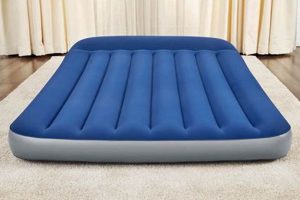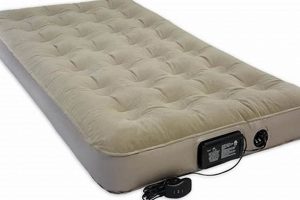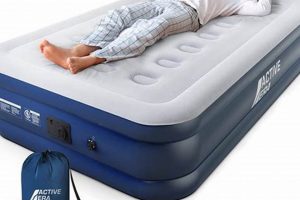This type of specialized support surface utilizes a large volume of air forced through a bed of fine particles, typically ceramic beads, creating a fluid-like medium. The patient rests on this fluidized surface, which minimizes pressure points and shear forces. An example of its application is in the treatment of severe burns and pressure ulcers, where skin integrity is compromised and requires maximum offloading.
The significant advantage lies in the reduction of pressure on vulnerable tissues, promoting circulation and aiding in wound healing. Historically, these surfaces were developed to address the challenges of managing patients with extensive skin damage and prolonged immobility. Their introduction marked a significant advancement in pressure injury prevention and management protocols within healthcare settings.
The following sections will delve into the construction specifics, clinical applications, maintenance procedures, and considerations for patient suitability relating to advanced support surfaces designed to optimize tissue perfusion and minimize the risk of skin breakdown.
Key Considerations for Utilizing Air Fluidized Therapy
The effective implementation of air fluidized therapy hinges on several critical factors. Attention to these guidelines optimizes therapeutic outcomes and minimizes potential complications.
Tip 1: Patient Selection: Appropriate candidates include those with Stage III or IV pressure injuries, extensive burns covering a significant body surface area, or compromised skin grafts/flaps requiring maximal pressure offloading. Carefully assess patient conditions to ensure suitability.
Tip 2: Temperature Management: Due to increased air circulation, patients are susceptible to heat loss. Closely monitor core body temperature and implement warming measures such as blankets or climate control to maintain normothermia.
Tip 3: Hydration Monitoring: The fluidized environment can contribute to insensible fluid loss. Vigilant monitoring of hydration status is crucial, and intravenous fluid replacement may be necessary, particularly in patients with pre-existing dehydration risks.
Tip 4: Skin Integrity Assessment: Despite pressure reduction, regular skin inspections are paramount. Monitor for any signs of skin irritation or breakdown, especially in areas exposed to prolonged contact with the mattress cover.
Tip 5: Infection Control Practices: Adherence to strict infection control protocols is essential. Regularly clean and disinfect the mattress surface per manufacturer guidelines to minimize the risk of pathogen transmission. Special attention should be paid to moisture management.
Tip 6: Weight Limitations: Adhere to the specified weight capacity of the particular model of air fluidized therapy support. Exceeding the weight limit can compromise the effectiveness of the pressure redistribution and potentially damage the equipment.
Tip 7: Proper Training and Education: Ensure that all healthcare personnel involved in the patient’s care are thoroughly trained in the operation and maintenance of the device. This includes understanding pressure mapping and proper patient positioning techniques.
Adherence to these guidelines will optimize the therapeutic benefits of utilizing this advanced support surface while mitigating potential risks. Consistent monitoring and proactive management are paramount to achieving positive patient outcomes.
The subsequent sections will explore specific clinical studies evaluating the efficacy and cost-effectiveness of air fluidized therapy in various patient populations.
1. Pressure Redistribution
The core function of an air fluidized mattress centers on its ability to redistribute pressure across the patient’s body surface. Conventional support surfaces concentrate pressure on bony prominences, such as the sacrum, heels, and hips, which impedes blood flow and leads to tissue ischemia and subsequent pressure injury formation. The design of these devices, employing air forced through a bed of fine particles, creates a fluid-like environment that effectively “floats” the patient. This floating effect disperses the patients weight over a larger contact area, thereby reducing the pressure exerted on any single point. For instance, a patient with a sacral pressure ulcer benefits from the minimized direct pressure on the affected area, fostering improved circulation and accelerated healing. The significance of pressure redistribution, therefore, as a fundamental characteristic of these devices, is paramount.
To quantify this pressure reduction, consider a standard hospital mattress versus an air fluidized mattress. On a standard mattress, pressure mapping studies frequently reveal peak pressures exceeding 60 mmHg on bony prominences. Prolonged exposure to pressures above 32 mmHg compromises capillary perfusion, increasing the risk of pressure injury. In contrast, an air fluidized system can demonstrably lower these peak pressures to below the critical threshold, often maintaining pressures below 20 mmHg. This substantial reduction facilitates unimpeded blood flow, crucial for tissue viability. Practically, this translates to reduced incidence of new pressure injuries and improved healing rates for pre-existing wounds. Clinical practice demonstrates that patients placed on air fluidized mattresses exhibit a significantly lower rate of pressure injury development, particularly those with limited mobility or compromised nutritional status.
In summary, pressure redistribution is not merely a feature but the defining functional attribute. The efficacy of an air fluidized mattress in preventing and treating pressure injuries stems directly from its capacity to minimize localized pressure points. While considerations like temperature regulation and fluid balance are important adjuncts to care, pressure redistribution remains the cornerstone of its therapeutic benefit. Challenges remain in balancing the cost of these specialized surfaces with their demonstrated clinical advantages; however, their capacity to redistribute pressure remains a significant advance in preventative and therapeutic care.
2. Temperature Regulation
Temperature regulation presents a critical consideration when utilizing an air fluidized mattress. The inherent design of these systems, which involves circulating air through a bed of fine particles, can impact a patient’s thermal balance. This necessitates proactive monitoring and management to prevent complications associated with temperature dysregulation.
- Increased Convective Heat Loss
The constant flow of air across the patient’s skin surface increases convective heat loss. This is particularly pronounced in patients with compromised thermoregulation, such as the elderly, neonates, or individuals with extensive burns. Unmitigated, this can lead
to hypothermia, shivering, and increased metabolic demand. In a clinical setting, careful monitoring of core body temperature is vital, and supplemental warming measures, such as blankets or radiant warmers, are often necessary. - Impaired Vasoconstriction
Patients with impaired vasoconstriction, often seen in those with spinal cord injuries or certain medications, are particularly vulnerable to temperature fluctuations on these surfaces. The reduced ability to constrict blood vessels in response to cold further exacerbates heat loss. Therefore, healthcare providers must exercise heightened vigilance in assessing and managing the thermal environment of these patients.
- Impact of Ambient Temperature
The ambient temperature of the room significantly influences the patient’s thermal balance. A colder room will amplify heat loss, while a warmer room may lead to hyperthermia, particularly in patients with impaired sweating mechanisms. Maintaining a stable and appropriate room temperature is essential for minimizing thermal stress. Room temperature should be adjusted in coordination with the device’s temperature control settings.
- Importance of Monitoring Equipment
Accurate and continuous temperature monitoring is paramount. Employing reliable temperature probes and regularly assessing the patient’s subjective comfort level assists in tailoring warming or cooling interventions. Furthermore, recognizing the signs and symptoms of both hypothermia and hyperthermia is crucial for timely intervention. Changes in mental status, shivering, or flushing should prompt immediate investigation and appropriate management.
In conclusion, while an air fluidized mattress offers significant benefits in pressure redistribution and wound management, careful attention to temperature regulation is imperative. Integrating proactive monitoring strategies, maintaining a stable thermal environment, and implementing appropriate warming or cooling measures will optimize patient outcomes and minimize the risk of thermal complications associated with these specialized support surfaces. These factors help maintain overall patient comfort and well-being, contributing to a more effective healing process.
3. Fluid Loss
The utilization of an air fluidized mattress introduces a significant consideration concerning patient fluid balance. The design of these systems, characterized by the circulation of air, intrinsically elevates the potential for insensible fluid losses, demanding vigilant monitoring and proactive management to mitigate associated risks.
- Increased Evaporation
The continuous movement of air across the skin surface promotes evaporation, accelerating the rate at which fluid is lost from the body. This evaporative loss is particularly pronounced in patients with compromised skin integrity, such as those with burns or open wounds. The disrupted epidermal barrier allows for increased transepidermal water loss. For instance, a patient with extensive burns may experience significantly elevated fluid requirements when placed on these support surfaces, necessitating careful titration of intravenous fluids to maintain adequate hydration.
- Respiratory Fluid Loss
While the primary mechanism of fluid loss relates to cutaneous evaporation, the increased air circulation can also indirectly contribute to respiratory fluid losses. The drier air environment may increase the rate of insensible water loss from the respiratory tract, particularly in patients who are breathing through an open airway. This effect is generally less significant than evaporative losses from the skin but should be considered in the overall assessment of fluid balance.
- Impact of Ambient Humidity
The degree of fluid loss is directly influenced by the ambient humidity levels. Lower humidity environments exacerbate evaporative losses, further increasing the risk of dehydration. Conversely, higher humidity can mitigate these losses. Therefore, monitoring and adjusting the room’s humidity, when possible, can play a role in managing fluid balance. In arid climates, the need for vigilant fluid management is amplified. The ambient humidity should ideally be maintained within a physiological range to minimize impact on fluid loss.
- Compromised Thirst Mechanisms
Certain patient populations, such as the elderly or those with neurological impairments, may have compromised thirst mechanisms. These individuals may not adequately perceive or respond to dehydration, making them particularly vulnerable to fluid imbalances when placed on an air fluidized mattress. Regular assessment of hydration status, including monitoring urine output and serum electrolyte levels, is crucial. Proactive fluid replacement strategies may be necessary to prevent dehydration in these vulnerable individuals. Educating caregivers on the importance of fluid intake and recognizing signs of dehydration is also essential.
In summary, managing fluid loss is an integral component of care for patients utilizing an air fluidized mattress. Recognizing the mechanisms that contribute to fluid loss, monitoring hydration status, and implementing appropriate fluid replacement strategies are essential for optimizing patient outcomes and minimizing the risks associated with dehydration or electrolyte imbalances. Such proactive management ensures the therapeutic benefits of the air fluidized mattress are maximized, while patient comfort and safety are maintained.
4. Infection Control
Maintaining stringent infection control practices is paramount when utilizing an air fluidized mattress. The design of these surfaces, while offering therapeutic benefits, presents unique challenges regarding microbial contamination and transmission. The porous nature of the fluidized bed and the potential for fluid accumulation create an environment conducive to microbial growth, necessitating strict adherence to protocols designed to mitigate infection risks.
- Biofilm Formation in Fluidized Bed
The interstices within the ceramic beads or other particulate matter forming the fluidized bed can harbor microorganisms, leading to biofilm formation. These biofilms are resistant to many conventional disinfectants, complicating decontamination efforts. Regular and thorough cleaning protocols, utilizing manufacturer-recommended cleaning agents with proven efficacy against biofilms, are essential. Failure to address biofilm formation can result in persistent contamination and increased risk of nosocomial infections. Regular replacement of the particulate matter may also be warranted, depending on the frequency of use and the patient population.
- Moisture Management and Microbial Growth
The potential for fluid accumulation from wound drainage, perspiration, or incontinence creates a moist environment that promotes microbial proliferation. Regular inspection and cleaning of the mattress surface are necessary to remove any accumulated fluids. Utilizing waterproof and vapor-permeable mattress covers can help to protect the fluidized bed from contamination. Incontinence management strategies are also crucial to minimize fluid exposure. The selection of appropriate mattress covers and absorbent materials should be guided by infection control principles.
- Airborne Dissemination of Microorgani
smsThe forced air circulation inherent in these devices has the potential to aerosolize microorganisms from contaminated surfaces, leading to airborne dissemination. Employing appropriate air filtration systems and implementing source control measures, such as covering wounds and utilizing personal protective equipment (PPE), can help to mitigate this risk. The use of air purification devices with HEPA filters may be considered in high-risk environments. Ventilation systems should be regularly maintained to ensure optimal air exchange rates.
- Cleaning and Disinfection Protocols
Implementing standardized cleaning and disinfection protocols is critical for minimizing contamination. These protocols should encompass regular cleaning schedules, the use of appropriate disinfectants with proven efficacy against relevant pathogens, and adherence to recommended contact times. Healthcare personnel must be thoroughly trained in these protocols, and compliance should be monitored regularly. Manufacturer guidelines for cleaning and disinfection should be strictly followed, and documentation of cleaning activities is essential for maintaining accountability.
The relationship between infection control and air fluidized mattresses is an essential consideration in any healthcare setting where these surfaces are utilized. By implementing comprehensive strategies to address biofilm formation, manage moisture, control airborne dissemination, and adhere to rigorous cleaning protocols, the risks of infection can be significantly minimized, ensuring patient safety and promoting optimal therapeutic outcomes. The proactive approach to infection control is crucial for harnessing the benefits of air fluidized therapy while mitigating the potential for adverse events.
5. Patient Selection
Appropriate patient selection is a critical determinant of successful outcomes when employing an air fluidized mattress. The inherent properties of this specialized support surface are not universally beneficial and may even be detrimental if applied indiscriminately. The primary indication revolves around patients at high risk of, or already experiencing, significant pressure injuries. A direct consequence of inappropriate selection is the potential for adverse effects, such as unnecessary fluid loss, temperature dysregulation, or exposure to infection risks without commensurate clinical benefit. Real-life examples include patients with minimal pressure injury risk being placed on the device, leading to dehydration and increased care complexity without any improvement in skin integrity. Understanding the specific criteria that warrant the use of an air fluidized mattress is therefore paramount for optimizing patient care and resource allocation.
Furthermore, patient selection must consider not only the presence and severity of pressure injuries but also co-morbidities that may influence tolerance to the support surface. For example, patients with pre-existing pulmonary conditions may experience respiratory distress due to the increased air circulation inherent in the design. Similarly, individuals with significant cognitive impairment may not tolerate the altered sensory environment, leading to agitation and increased risk of falls. Practically, this necessitates a comprehensive assessment that encompasses a patient’s overall medical condition, functional status, and cognitive abilities before initiating therapy with an air fluidized mattress. Clinical experience demonstrates that a multidisciplinary approach, involving physicians, nurses, and therapists, enhances the accuracy of patient selection and minimizes the risk of adverse events. Cases where careful selection was followed show marked improvement in wound healing.
In conclusion, the effectiveness of an air fluidized mattress is inextricably linked to judicious patient selection. The potential benefits of pressure redistribution and enhanced wound healing are realized only when the surface is applied to individuals who meet specific clinical criteria and are able to tolerate its inherent characteristics. Challenges persist in developing standardized guidelines for patient selection, but a thorough assessment of individual needs and co-morbidities, coupled with a multidisciplinary approach, remains the cornerstone of responsible and effective utilization. Failing to prioritize appropriate selection compromises the value of air fluidized therapy and may lead to avoidable harm.
Frequently Asked Questions Regarding Air Fluidized Mattresses
This section addresses common inquiries concerning the functionality, application, and maintenance of air fluidized mattresses within healthcare settings.
Question 1: What are the primary clinical indications for using an air fluidized mattress?
The primary indications include the management of Stage III and IV pressure injuries, extensive burns covering a significant percentage of total body surface area, and compromised skin grafts or flaps requiring maximum pressure offloading. These devices are also considered for patients with multiple pressure injuries or those at high risk for developing them due to immobility or compromised nutritional status.
Question 2: What are the contraindications for using an air fluidized mattress?
Contraindications may include patients with unstable spinal fractures, those requiring skeletal traction that would be compromised by the fluidized surface, and individuals with severe pulmonary conditions where increased air circulation could exacerbate respiratory distress. Relative contraindications include patients with severe agitation or uncontrolled movements that could disrupt the integrity of the mattress or increase the risk of falls.
Question 3: How does an air fluidized mattress differ from other types of pressure redistribution surfaces?
Unlike traditional foam or alternating air mattresses, these mattresses utilize a bed of ceramic beads through which air is forced, creating a fluid-like environment that minimizes pressure and shear forces. This unique design allows for greater pressure redistribution and immersion compared to other surfaces. Alternating air mattresses, for example, redistribute pressure cyclically, while foam mattresses conform to the body’s shape but may not provide the same level of pressure relief.
Question 4: What are the key considerations for maintaining proper hygiene and preventing infection on an air fluidized mattress?
Maintenance involves regular cleaning and disinfection of the mattress surface using manufacturer-recommended cleaning agents. Waterproof and vapor-permeable mattress covers are essential to protect the fluidized bed from contamination. Strict adherence to infection control protocols, including hand hygiene and the use of personal protective equipment, is paramount. Routine inspection for fluid accumulation and prompt cleaning of any spills is also critical.
Question 5: How does the forced air circulation affect patient temperature and hydration?
The increased air circulation can lead to convective heat loss and insensible fluid losses. Therefore, it is essential to closely monitor patient temperature and hydration status. Supplemental warming measures, such as blankets or radiant warmers, may be necessary to prevent hypothermia. Intravenous fluid replacement may be required to maintain adequate hydration, particularly in patients with pre-existing dehydration risks.
Question 6: What are the typical weight limitations for an air fluidized mattress?
Weight limitations vary depending on the
specific model and manufacturer. Exceeding the specified weight capacity can compromise the effectiveness of the pressure redistribution and potentially damage the equipment. It is essential to consult the manufacturer’s guidelines to determine the appropriate weight limit for a given device. Bariatric models are available to accommodate patients exceeding standard weight limits.
In summary, understanding the nuances of air fluidized mattresses is crucial for effective implementation and optimal patient outcomes. Careful consideration of indications, contraindications, maintenance requirements, and potential complications is essential for maximizing the benefits of this specialized support surface.
The subsequent section will address emerging technologies and future directions in pressure injury prevention and management.
Air Fluidized Mattress
This discussion has provided a comprehensive overview of the air fluidized mattress, underscoring its function in pressure redistribution, its challenges in temperature and fluid management, the necessity of strict infection control, and the importance of appropriate patient selection. The unique design of this support surface allows for significant pressure offloading, proving beneficial in the management of severe pressure injuries and extensive burns. However, the potential for adverse effects necessitates careful consideration and adherence to established guidelines.
Ongoing research and technological advancements are expected to refine the design and application of air fluidized therapy. Future efforts should focus on mitigating the challenges associated with temperature regulation and fluid loss, enhancing infection control measures, and developing more precise patient selection criteria. The continued evaluation of clinical efficacy and cost-effectiveness will be essential to ensure the responsible and optimal utilization of this specialized support surface, ultimately leading to improved patient outcomes in complex wound care scenarios.







